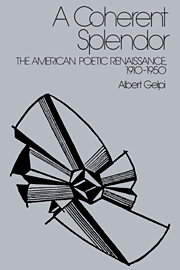Book contents
- Frontmatter
- Contents
- Acknowledgments
- Dedication
- Introduction. The Janus-Face of Romanticism and Modernism
- 1 Robert Frost and John Crowe Ransom: Diptych of Ironists, the Woodsman and the Chevalier
- 2 Wallace Stevens: World as Mundo, Mundo as World
- 3 T. S. Eliot: The Lady Between the Yew Trees
- 4 Ezra Pound: Between Kung and Elcusis
- 5 H. D.: Helen in Bethlehem, Hilda in Egypt
- 6 William Carlos Williams: Mother-Son and Paterson
- 7 Allen Tate and Hart Crane: Diptych with Angels and Demons
- Coda. Yvor Winters and Robinson Jeffers: The Janus-Face of Anti-Modernism
- Notes
- Index
3 - T. S. Eliot: The Lady Between the Yew Trees
Published online by Cambridge University Press: 22 January 2010
- Frontmatter
- Contents
- Acknowledgments
- Dedication
- Introduction. The Janus-Face of Romanticism and Modernism
- 1 Robert Frost and John Crowe Ransom: Diptych of Ironists, the Woodsman and the Chevalier
- 2 Wallace Stevens: World as Mundo, Mundo as World
- 3 T. S. Eliot: The Lady Between the Yew Trees
- 4 Ezra Pound: Between Kung and Elcusis
- 5 H. D.: Helen in Bethlehem, Hilda in Egypt
- 6 William Carlos Williams: Mother-Son and Paterson
- 7 Allen Tate and Hart Crane: Diptych with Angels and Demons
- Coda. Yvor Winters and Robinson Jeffers: The Janus-Face of Anti-Modernism
- Notes
- Index
Summary
In the imperious humility of his last years, as Ezra Pound ruminated on the indebtedness to Dante which he shared with T. S. Eliot, an American expatriate poet like himself, he wrote of the recently dead friend from his early London years: “His was the true Dantescan voice – not honoured enough, and deserving more than I ever gave him.… I can only repeat, but with the urgency of 50 years ago: READ HIM.” From their first association, Eliot seemed to Pound the only serious poetic contender in his generation, yet he promoted Eliot's work and plotted to relieve his poverty until their ways diverged, poetically and intellectually as well as geographically, during the 1920s. Their association and their differences will be implicit throughout this discussion because together both the association and the differences, as between Stevens and Williams, offer another way of understanding the dialectic between Symbolisme and Imagism which has produced the range and diversity of American poetry in this century.
They recognized that their differences were as basic as their allegiances. In the divisive “years of Ventre deux guerres,” Pound was not always deferential to Eliot; he twitted the Christian commitment of the “Rev. Mr. Eliot,” and in Canto 46 implied weakness and escapism for “wanting to get through hell in a hurry.” Eliot's work refutes the charge, but when Eliot in turn criticized Pound's hell as a place imagined for other people but not for Pound himself, he was suggesting that it was Pound who wanted to get through hell in a hurry, while implicitly acknowledging his own sense of being in hell, or at least in purgatory.
- Type
- Chapter
- Information
- A Coherent SplendorThe American Poetic Renaissance, 1910–1950, pp. 91 - 168Publisher: Cambridge University PressPrint publication year: 1988



